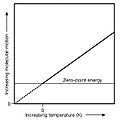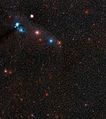Zero-point energy facts for kids
Zero-point energy is the energy that exists even in empty space. It's like a tiny hum of energy that's always there, even when everything else is gone. Imagine the space between the tiny particles inside atoms. Even that "empty" space has energy!
Scientists have different ideas about how much zero-point energy there is. Some think it's very, very small, almost zero. Others believe it's impossible to know the exact amount. And some theories suggest that a tiny bit of empty space, like a cubic centimetre, could hold more energy than what was needed to create the Big Bang!
Contents
What is Zero-Point Energy?
Zero-point energy is the lowest possible energy a system can have. It's the energy that remains even when you cool something down as much as possible. It's a key idea in quantum physics, which studies the smallest particles in the universe.
Why "Zero-Point"?
The name "zero-point" comes from experiments with helium. When you cool helium down to almost absolute zero (0 kelvin, which is about -273 degrees Celsius), it doesn't freeze solid like most other materials. Instead, it stays a liquid! This happens because of zero-point energy. Even at super cold temperatures, the helium atoms still have a tiny bit of energy that keeps them moving. This energy prevents them from settling down and freezing.
Zero-Point Energy and the Universe
The idea of zero-point energy connects to how we understand the universe.
Tiny Particles and Strings
Physics explores matter from big to small. We know about atoms, then subatomic particles like electrons, protons, and neutrons. Even smaller are quarks and gluons that make up protons and neutrons.
Now, string theory suggests that these smallest particles are actually tiny, vibrating strings of energy. These strings are incredibly thin, with almost no width. If everything is made of these vibrating strings, then all the matter in the universe could have started from a very small space. This idea fits with the Big Bang theory, which says the universe began from an extremely dense and hot point.
Energy in Empty Space
If string theory is true, it supports the idea that there's a lot of energy in empty space. This "large energy" view of zero-point energy suggests that the vacuum isn't truly empty. Instead, it's full of tiny, fluctuating energies. This energy could be a huge source of power, but we don't yet know how to use it.
Images for kids
-
Liquid helium retains kinetic energy and does not freeze regardless of temperature due to zero-point energy. When cooled below its Lambda point, it exhibits properties of superfluidity
-
Planck in 1918, the year he received the Nobel Prize in Physics for his work on quantum theory
-
Timeline of the metric expansion of space. On the left, the dramatic expansion occurs in the inflationary epoch.
See also
 In Spanish: Energía del punto cero para niños
In Spanish: Energía del punto cero para niños











